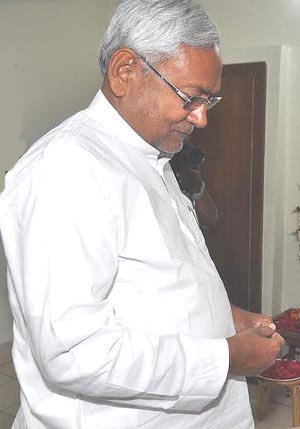|
10/05/2014
Has Nitish Kumar lost his destination?
|
Of the countless roads built in Bihar in the last few years only one, the Golden Quadrilateral, directly leads to Delhi. While linking Kolkata to the national capital it passes through four parliamentary constituencies of south Bihar––Gaya, Aurangabad, Karakat and Sasaram––before entering UP. Incidentally, in none of them the ruling Janata Dal (United) is sure of victory. The Bharatiya Janata Party-led combination as well as the Rashtriya Janata Dal-Congress alliance appear much more confident in them. This four seats symbolize the real situation in Bihar, where the electoral battle has almost become straight with JD(U) hardly in contest in most of them. The big unsolved mytery is why the road to Delhi has become so difficult for Nitish Kumar, who till recently, used to be applauded for ‘turning-around’ Bihar’s economy. The problem is that Nitish stumbled while chosing the right road for himself. He failed to learn a lesson from bête noire Lalu, whose party was virtually decimated after 2009 Lok Sabha and 2010 state Assembly elections. Contrary to this he won elections between 1990 and 2004 quite comfortably when as the chief minister or de facto CM he did not do much for the development of Bihar. RJD got derailed after 2005 because the party went on wrong track. The alliance with the Congress had collapsed and thus Lalu was completely marginalized. However, he mended his ways and brought the party back on the track by aligning with the Congress. Thus the alliance once again emerged as a force in the state. Nitish also got an opportunity to join hands with the Congress, but he squandered it as he over-estimated his strength after the split with the BJP. Building roads, bridges and laying railway tracks do not always pave the way for victory in polls. Anyway the NDA government was already rewarded for some good works it did in 2009 and 2010 elections. The upper castes were now more keen to know about the political road he is taking. After June 16, 2014 split, the BJP launched a higly aggressive campaign to deny credit to the chief minister for the achievements of the state government. Its leaders went on to claim that whatever achievements had been made it was because of 11 ministers of the BJP in the cabinet. Suddenly the same Sushil Kumar Modi, who till a few months back, would see prime ministerial material in Nitish, and not in Narendra Modi, would repeatedly claim that he is heading the most inefficient and corrupt government and that the state machinery has collapsed and loot are rampant all over Bihar. Not only that Nitish is accused of being soft towards terrorism––the Mahabodhi Temple and Patna blasts are cited as reasons. Interestingly, Narendra Modi, once while speaking in Bihar, attributed the backwardness of the state, to the absence of any government in the last 20 years. What he forgot to understand is that his party was sharing power for seven and a half years with Nitish and before 1990 the state was ruled by the Congress. Now questions are being asked as to how can Nitish alone take credit for most of the central government projects. Be it the Golden Quadrilateral or East-West Porbandar-Silchar Corridor, both were the projects initiated by the Vajpayee government, so was the Pradhan Mantri Gram Sadak Yojana by the UPA. Similarly, how can a state government take credit for the opening of IIT, central universities and even Nalanda University, an international project, and the brainchild of former President, A P J Abdul Kalam. As Nitish grew weak politically the once friendly media turned its back on him. Gradually stories of loots, dacoities, scams, gang-rapes, lawlessness, rampant corruption etc––which used to be underplayed earlier––started hitting headlines. Now hardly anyone talks about the bi-cycle distribution and uniform schemes without mentioning corruption in them. Nitish is being blamed for the collapse in school education. Resentment started brewing up since 2006 when he initiated steps to empower Extremely Backward Castes and Mahadalits. He wove a social alliance of upper caste with the EBCs and Mahadalits so that Lalu could be kept at bay. The move required a careful handling as in the Maoists-hit agrarian Bihar the two groups are on different sides of the battleline. The upper castes questioned his decision to increase the quota of women from 33 to 50 per cent in urban and rural local bodies and fixing 20 per cent seats for the EBCs. Dalits already had 16 per cent reservation. Though the empowerment of women was hailed across the country in Bihar many people looked at the move suspiciously as only 14 per cent seats were left for the general caste males––and that too when panchayats have come to enjoy so much power at the grassroots level. As if that was not enough. Nitish set up Bandopadhyay Commission to empower the sharecroppers. The landed castes were furious and on May 10, 2010 a massive Kisan Mahapanchayat was organized in Patna. Nitish was forced to abandon the idea. In the same way his government went on to economically and socially empower 21 out of 22 Dalit castes and created a new category, Mahadalit, for them. The only Dalit caste left was Paswans. In spite of all these steps the NDA managed to win the 2009 and 2010 elections as the upper castes did not want the return of Lalu-Rabri regime. But by the time Nitish broke his ties with the BJP the upper castes had got in Modi an alternative. So in Bihar the BJP is cashing in on the anger against Nitish rather than against UPA-II. Nitish gauged the mood of the upper castes quite early. He started wooing Muslims to make up for the loss of upper castes. A month after the Kisan Mahapanchayat he on June 12, 2010 cancelled the dinner hosted for the BJP top brass in Patna, including that of Modi. They were here to attend the national executive of the BJP. He snapped ties with the BJP though he was the man, who months after Gujarat riots openly requested Narendrabhai to play a much larger role in the Centre. True, in 2009 and 2010 some Muslims did vote for the JD(U)-BJP alliance, but then Modi was not in the picture. After the split in the NDA the message went to the masses that Nitish has become vulnerable. Thus even some EBCs and Mahadalits started questioning his ability to win election. While Muslims drifted towards the RJD as they wanted to stop Modi, at places even the EBCs and Mahadalits jumped to the BJP bandwagon leaving Nitish high and dry. comments powered by Disqus |
|



